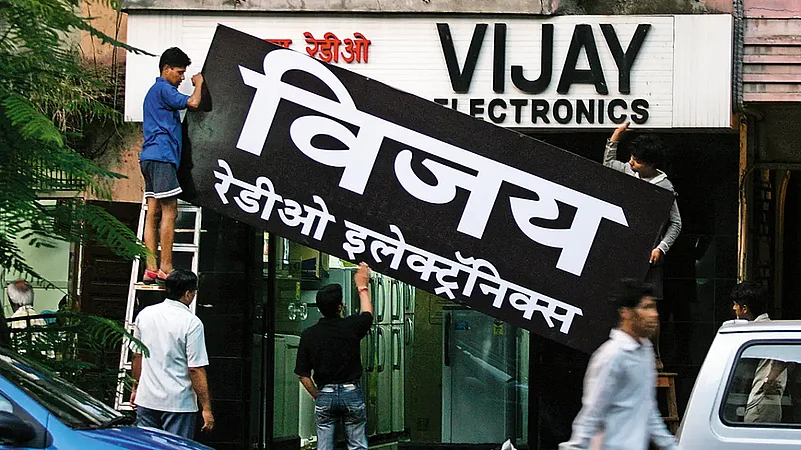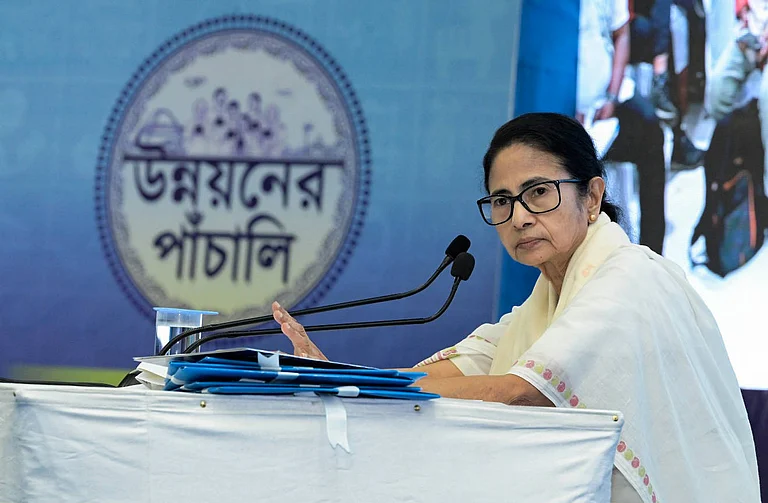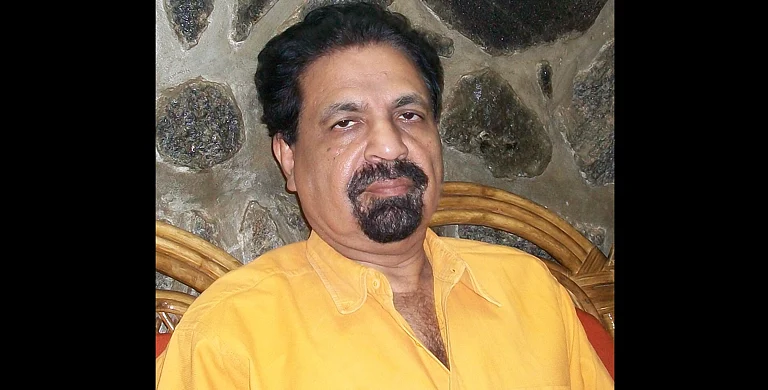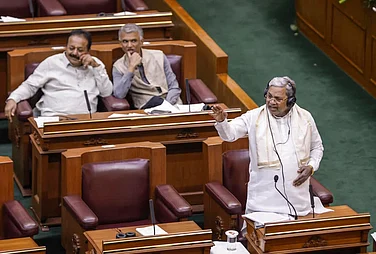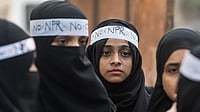Some decades ago, when the Shiv Sena—led by its founder and unapologetic Hindutva mascot Bal Thackeray—issued warnings to shopkeepers in Mumbai to change their signboards from English to Marathi, few paid heed. Some days later, the verbal warnings took on a violent shape when lathi-wielding Shiv Sainiks took to the streets and vandalised the signboards. Even shops owned by Maharashtrians were not spared as they sported English signboards. In the years since then, the party’s promotional agenda for Marathi has been marred by violence. Old-timers who lived through the era, when the Shiv Sena’s “only Marathi language in Mumbai” agenda had become its central theme, say that the party had not moved any further. “Though the party had steadfastly held on to the Marathi agenda, the leaders have not followed it in their own lives. The children of all the leaders have studied in expensive English-medium schools and colleges. Emulating them, the cadre too sent their children to English-medium schools. So essentially, it was a half-hearted attempt to impose Marathi on the non-Marathi speaking people,” says a historian who has closely followed the development of the party over the years.
Despite the tough posturing by the Shiv Sena and the violent agitations, senior leaders of the party confess that the Marathi language is on a downward spiral. “I have been with the party for decades. My wife was firm that our children would not study in a Marathi-medium school. My grandchildren live abroad and have no connect with Marathi,” a senior party member tells Outlook requesting anonymity. The children of the incumbent Shiv Sena chief and chief minister Uddhav Thackeray, the children of his siblings, including the ones of his cousin Raj Thackeray—the chief of the Maharashtra Navnirman Sena—all studied in top English-medium institutions run by Jesuit priests, even as the party was imposing its Marathi-only diktat.
ALSO READ: Let A Language Contend
Sai Pendse, who has been teaching Marathi for the past 23 years, says that children today study the language because they have to pass in the subject. “It is a compulsory subject in every school, so they study to pass. There is no commitment to learning Marathi. While the Marathi tongue is very important, English is the aspirational language, the licence to the global world. The households that speak Marathi are reducing,” Pendse tells Outlook. According to educationists, enrolment in English-speaking courses has seen a multifold increase. “Children of domestic help, security guards, grocers, autorickshaw drivers and many more in this strata, send their children to English-medium schools in the hope of bettering their lives. They borrow money for this. Even if it takes a lifetime to pay back the debts they want their children to learn English,” said Prashant Salunkhe, a private English tutor.

Marathi, the primary language of Maharashtra, is going through a churn, facing an existential crisis. Despite the long standing but sporadic outbursts by the Shiv Sena and the Raj Thackeray-led MNS—self-styled custodians of the Marathi language—demanding that Marathi be made compulsory for everyone in the state, the downward spiral of the language continues. Since the 1960s, when the Shiv Sena burst into the political space of Mumbai, agitations for the compulsory implementation of the language across Maharashtra became the mainstay of the party’s political agenda.
Even before the formation of a unified Maharashtra in 1960, language politics as identity politics has been a subject of much debate. Language politics got a push from injustices—whether imagined or real—to the linguistic community. Though the state’s first chief minister, Yeshwantrao Chavan, had established Bhasha Sanchalanalay (Directorate of Languages), Sahitya and Sanskruti Mandal (Board of Literature and Culture), Vishwakosh Nirmiti Mandal (Board for Marathi Encyclopaedia) and numerous other institutions, in the years since then the lack of political will has seen the decline of Marathi, say sources. Although the Marathi Official Languages Act, 1965, was brought in to strengthen the Marathi language, the reverse took place. “There was no cut-off date for transacting all administrative work in Marathi. It was kept open. There was no political will to see the empowerment of Marathi as a language,” says a source in the Marathi Bhasha Department. “Even today announcements are made but there is a general lethargy to see it through.”

In 2008, the Brihanmumbai Municipal Corporation (BMC) had made it mandatory for all shops and establishments to put up signboards in Marathi. This was in reaction to an agitation launched by MNS. The Federation of Retail Traders Welfare Association had moved the Bombay High Court, which castigated the Maharashtra Government for mishandling the issue. Following the order of the High Court, the BMC withdrew the order. In February 2020, a bill passed by both the Maharashtra legislative assembly and the legislative council made Marathi compulsory from classes one to 10 in all schools and across all school boards in the state. A month later, another Bill was passed by the legislature making the use of Marathi compulsory in all official works, including that of the local authorities, civic bodies and corporations formed by the state government. This was to plug a loophole in the Maharashtra Official Language Act, 1964.
In March this year, yet another Bill was passed by the Maharashtra legislative assembly which made it mandatory for all shops and establishments—irrespective of their size—to use Marathi in the Devanagari script on their signboards. This is applicable to even those shops and establishments with less than 10 employees. Not to be left behind, the Education Department issued orders through its officers directing all schools – government, civic and private – to put up their signboards in the Marathi Devanagari script. The boards have to be prominently displayed in front of the school, stated the order. The University of Mumbai has directed all its affiliate colleges to use Marathi alongside English in its daily functioning. In the same month, Maharashtra Education Minister Varsha Gaikwad announced that the state government will introduce integrated, bilingual textbooks from class one in all the Marathi-medium schools across the state. This will commence from the next academic year (2022-2023).

After the 2008 fiasco, the BMC this month re-introduced the order for all shops and establishments to put up their signboards in the Marathi Devanagari script. The order mandated that the Marathi lettering must be more prominent than any other language on the signboard. If two languages are used on the signboard, the Marathi script should be in a bigger font than the other language. According to the BMC order, legal action will be taken against those violating the Maharashtra Shops and Establishments (Regulation of Employment and Conditions of Service) Act, 2017.
Highlighting the importance of peoples’ participation in strengthening the local languages, Dr Rajan Welukar—former vice chancellor of the University of Mumbai—felt that globalisation has put pressure on people to learn English. “The child gets its first expression in the mother tongue at home. If it is not spoken there, the child feels a disconnect,” Welukar tells Outlook. “With Marathi also, this is the case. Besides, Marathi drama, which is so powerful, is declining. Marathi literature finds no takers. There is less translated content from other languages available in Marathi,” he points out. According to Welukar, if aspects such as content availability, literature, drama and the spoken language are strengthened, Marathi will not have such a tough battle at survival.

There is no great news from the Marathi education sector either. Marathi schools across Mumbai are fighting for survival. In the decade from 2010 to 2020 about 133 Marathi schools have shut down. There has been a 65 per cent drop in the number of students studying in Marathi schools in Mumbai in the decade gone by. In 2019, the Marathi language saw the biggest dip in the pass percentage at the Class X level in the past five years. While in 2015, the pass percentage in the language in Class X was 93.86, by 2019 it had dropped to 78.42. While the Maharashtra government has a tie-up with the British Council and other projects to improve teaching of the English subject in schools, there is hardly any emphasis on Marathi literature and the way it is taught.
On the occasion of World Marathi Day every year, the issues plaguing the promotion and survival of the language are highlighted by linguistic experts, well-known writers and others. Later on, it remains just that—a discussion—until the next year. “The ever-increasing use of English in academics and the way the mother tongue is looked at in homes are the reasons for the decline of Marathi,” says Welukar.
(This appeared in the print edition as "Struggling to Survive")
ALSO READ
Haima Deshpande in Mumbai






